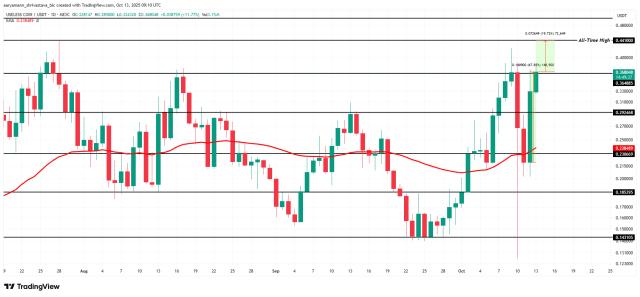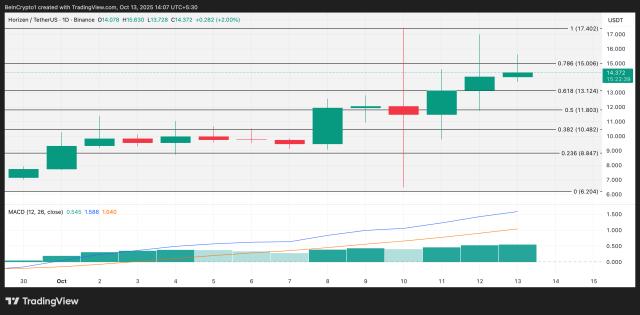Author: Chaos Labs Founder; Translation: Jinse Finance xiaozou
Last Friday, the DeFi space experienced perhaps one of its most significant black swan events yet. Theoretically, over $19 billion in liquidations occurred on centralized and decentralized exchanges (DEXs) with perpetual swaps, though the actual figure is likely much higher. Surprisingly, on-chain lending markets remained largely unaffected, but appearances can be misleading.
The market experienced a dramatic dislocation: on Binance, for example, the price of PAXG fell to $3,600.
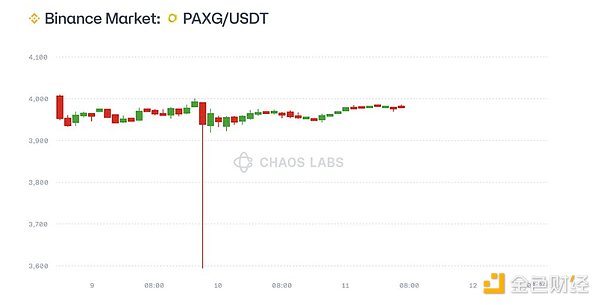
The price of EURC on Coinbase is $1.085.
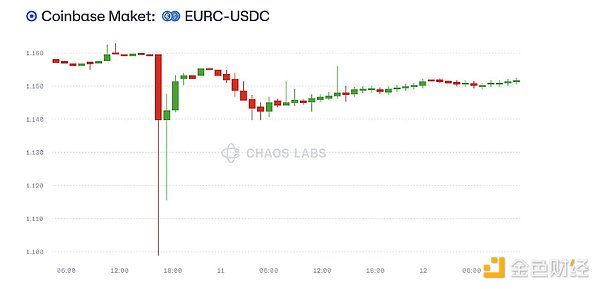
USDE fell to $0.65 on Binance.
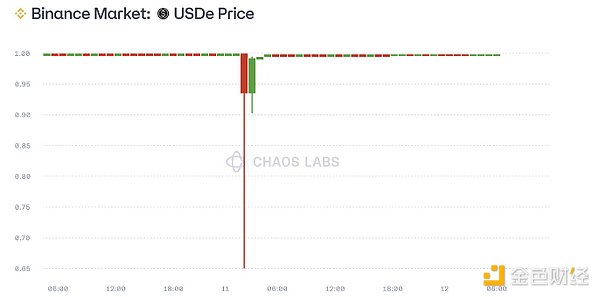
1. Not a de-anchor. Pricing deviations on a single trading platform do not equate to a loss of structural parity.
However, if the price gap persisted, the price impact would have spread to decentralized exchanges and lending markets, draining liquidity and triggering a cascading liquidation cycle that would have far outpaced the system's ability to withstand. On the Aave platform alone, $4.8 billion in positions were at risk, with potential liquidation penalties reaching $180 million. If these liquidations were executed, assets would have been reduced to zero before the stabilization mechanism could kick in.
We were able to avoid this outcome thanks to careful design decisions in risk management, a key one of which was maintaining a 1:1 pricing between USDe and USDT (kudos to the LlamaRisk team!).
2. Limitations of Traditional Oracles
Traditional price oracles are a pale reflection of what true oracles should be. They aggregate quotes from the secondary market and assume that these order books reflect fair value. This assumption works well for highly liquid, fungible assets, but it doesn’t hold true for the new asset-backed and mechanism-dependent tokens that dominate DeFi today.
For the following types of tokens:
USDe
Liquidity Re-collateralization Tokens (LRTs)
Principal Tokens (PTs)
Tokenized Real World Assets (RWAs)
Their value depends on the underlying liquidity, reserve composition, and redemption mechanism. Treating all tokens as homogeneous assets ignores these embedded dependencies and redemption paths that determine their true economic value.
A true oracle must delve into the essence. It needs to integrate every structural layer—reserves, counterparties, redemption logic, protocol logic, and dependencies—to produce a risk-aware measure of value. Otherwise, you're not pricing an asset, you're quoting volatility.
3. Integration of price, proof of reserve and risk mechanism
This is the intersection and integration of price oracles, proof of reserve oracles, and risk oracles. They are not independent systems, but interdependent within the same framework.
For asset-backed tokens, value cannot be defined solely by price oracles. It is derived from the union of market pricing and proven reserves, the product of the interaction between market observations and provable existence. Price oracles surface external market signals, reflecting secondary market behavior.
Proof of Reserve oracles anchor these signals to verifiable collateral assets, confirming the economic backing that gives meaning to the token’s value.
The risk oracle performs contextual analysis of the two and ultimately determines the actual value of the asset in a specific system based on the asset structure, liquidity and correlation with other risk exposures.
In other words, price without proof is just speculation, and proof without context is nothing more than static data.
The true valuation in the DeFi field depends on the real-time coordinated operation of three levels: market pricing, asset endorsement, and risk measurement.
While proof-of-reserve oracles are certainly progress, we're still far from the endgame. Currently, there's no standard for attestation frequency, nor is there a deep specification. The gaps between attestations create blind spots where solvency is assumed, not verified. Ideally, attestations should be continuous and real-time, allowing reserves to be dynamically observed and updated as conditions change. We're moving in this direction, but we're not there yet.
In the complex world of DeFi, oracles should be risk measurement tools tailored to specific use cases, not universal truth machines. Lending markets don't necessarily need to use the same oracle as perpetual swap exchanges. Each system needs to clearly define what volatility it's prepared to internalize and what risks it's willing to pass on downstream.
There is no free lunch: pricing stability always comes at the cost of transferring volatility elsewhere. The key question is who absorbs these risks and when.
For a lending system that prioritizes depositor safety, a hard-coded 1:1 parity may be a reasonable trade-off, but it is not the optimal or ultimate solution that works everywhere.
Underlying Net Asset Value (NAV) risk doesn’t disappear; it simply shifts. Good risk design should make this shift explicit, transparent, and reasonably priced.
4. The Way of Self-Discipline
If you are an asset issuer issuing tokenized RWAs, stablecoins, or money market instruments, you must establish a Proof of Reserves system and collaborate with oracles to provide PoR oracles. Without this guarantee, integrations such as lending markets, perpetual contract DEXs, and treasury managers are effectively granting blind trust to your solvency assumptions.
If you are an integrator:
Exchange
Loan Agreement
Vault Manager
You need to work directly with asset issuers and risk partners to gain a deep understanding of each asset’s structure, redemption logic, and reserve mechanism. Otherwise, risks that should be managed at the protocol level will be borne by your users.
5. The Road Ahead
Yesterday could have been “much worse” for DeFi.
We are building systems on a scale comparable to traditional finance, yet we haven't yet established the necessary self-regulatory rules. Real progress in financial infrastructure comes not from speed, but from accuracy, transparency, and shared standards. Every oracle, asset, and market design is a collection of trade-offs.
The next stage of DeFi will belong to those teams that recognize this nature early on and develop and build with a rigorous attitude - not those who move the fastest, but those who move in the right direction.




